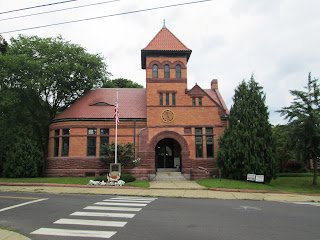The library. I had to ask directions to find it, but I got a cordial "welcome back" from the Walgreen's clerk. As you can imagine, I spent a good deal of time here as a kid. Walking the halls of old library, very little had changed (the reference section had been reordered to open up the reading room and create a Young Adult section). All my favorite books were where I remembered them. I even found the exact copy of The Talismans of Shannara that I read all those years ago. This little building (and the new wing cleverly imbedded in the hill beneath it) represent all that's best in civic space: beautiful but restrained architecture filled with worthy things for the common good. So let me take you on a little tour of one of my favorite places. There are no ghosts that I know of, except me.
The Reading Room, sitting immediately under the curved roof on the left side of the building.
The clock in the corner dates from the 16th century.
To the right is the old entry-way (no longer used). Forward is now the Young Adult section.
A view of the beautiful wooden roof over the Reading Room (stupid florescent lights).
The stacks in what was once the core of the old library. Below is the Connecticut room where works of local and historical interest are stored. I am the only ghost haunting this room.
Exterior of the building looking at the back of the Reading Room.
Light and Law. Very Victorian. Below, you can see a side view of the old building's tower with just the corner of the new building in view. The final picture is the view out over the Housatonic River Valley behind the library.
It was a rainy day when we came to visit. The old town knew me even if no one else did.
I cannot trade
My hands are empty
All I have are these
Broken memories
Little fragments red and gold
And the scent of maple smoke
Rising from forgotten chimneys in the valley of the soul
The Reading Room, sitting immediately under the curved roof on the left side of the building.
The clock in the corner dates from the 16th century.
To the right is the old entry-way (no longer used). Forward is now the Young Adult section.
A view of the beautiful wooden roof over the Reading Room (stupid florescent lights).
The stacks in what was once the core of the old library. Below is the Connecticut room where works of local and historical interest are stored. I am the only ghost haunting this room.
Exterior of the building looking at the back of the Reading Room.
Light and Law. Very Victorian. Below, you can see a side view of the old building's tower with just the corner of the new building in view. The final picture is the view out over the Housatonic River Valley behind the library.
It was a rainy day when we came to visit. The old town knew me even if no one else did.
I cannot trade
My hands are empty
All I have are these
Broken memories
Little fragments red and gold
And the scent of maple smoke
Rising from forgotten chimneys in the valley of the soul











Comments